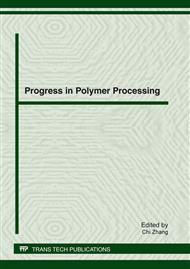p.457
p.463
p.467
p.473
p.479
p.484
p.489
p.495
p.500
Mechanical and Thermal Properties of Carbon Black Filled Natural Rubber and Fractal Analysis of Rubber Fracture Surfaces
Abstract:
Carbon black has been used as the main reinforcing fillers that increase the usefulness of rubbers. In this experiment, different compounds based on natural rubber were prepared with carbon black (N330) at various loading ratios from 10 to 125 phr. The mechanical and thermal properties of rubber compounds were measured and the test data with SEM micrographs were analyzed to determine the suitable ratio of carbon black for the desired properties of rubber compound. The results showed that carbon black particles were well dispersed in compounds with loading ratios of 25-30 phr, corresponding to maximum tensile strength values. While with the increase of carbon black content, heat conductivity kept sustained increase. Fractal dimension characterized the degree of uneven dispersion of carbon black in rubber fracture surfaces. A particular value of fractal dimension was obtained to characterize the optimum mechanical property of carbon black filled natural rubber. The thermal property and fractal dimension demonstrated same variation tendency.
Info:
Periodical:
Pages:
479-483
Citation:
Online since:
January 2012
Authors:
Price:
Сopyright:
© 2012 Trans Tech Publications Ltd. All Rights Reserved
Share:
Citation:


